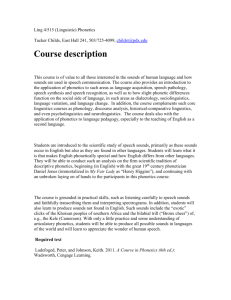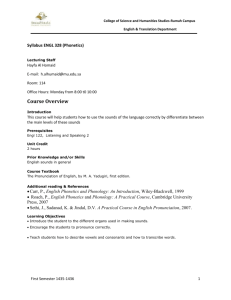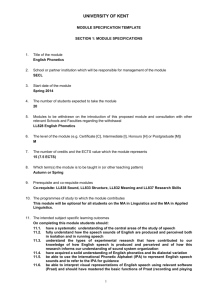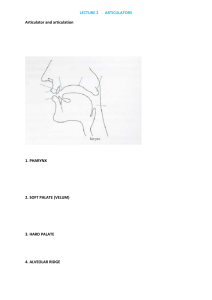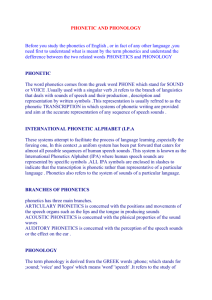PowerPoint Presentation - Got phones?
advertisement
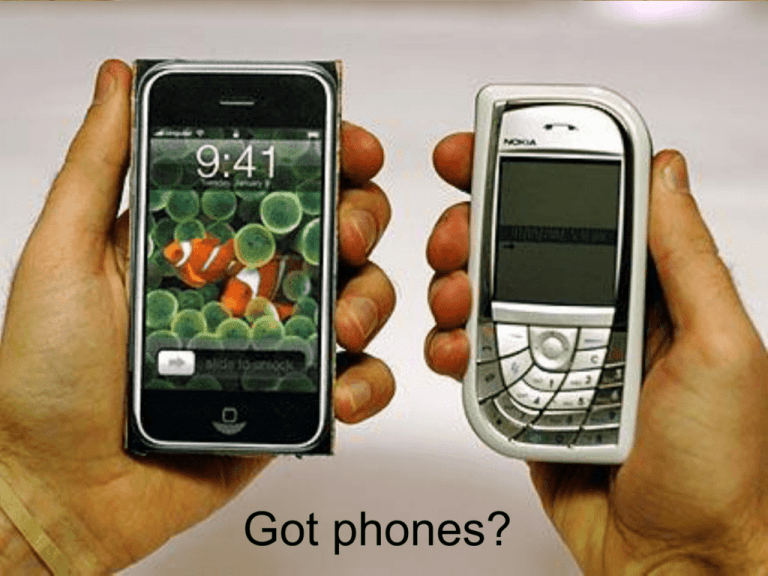
Got phones? QuickTime™ and a TIFF (Uncompressed) decompressor are needed to see this picture. Presented by Camille Fair-Bumbray TRED 256 July 2007 What is PHONETICS? • Phonetics comes from the Greek word φωνή (phone), or the morpheme phon~ which means sound • Phonetics then is the study of the sounds of human speech. Linguistic Knowledge Knowledge of Language Linguistic Knowledge Sounds Phonetics articulatory auditory how we say sounds how we perceive or hear sounds Words Sentence Structure Language Use Phonology Morphology Semantics Syntax Pragmatics sound system rules for combining sounds word formation internal structure meaning of word chunks (whole) word meaning rules for grammar how context and situation affect meaning So What’s the Chapter About? (Chapter Overview: The BIG 6) 1. 2. Definition of Phonetics Articulatory phonetics (speaking) v. auditory phonetics (listening) 3. Sound Segments 4. Spelling (Orthography)and Speech (pronunciation) 5. Articulatory Phonetics (“anatomy” and “physiology” of phonetics) – a. Initiation (airstream mechanisms) + Articulation (vocal tract) – b.Consonants: places of articulation, manners of articulation, phonetic symbols – c.Vowels & Dipthongs 6. Sign-Language But first… A few random…yet relevant thoughts *Why we chose PHONETICS *Why Phonetics is important *Phonetics? Phoneme? Phonology? Why phonetics? • Thought it was phonology • Discovered it wasn’t! • Realized I needed to understand the difference • Specifically: How can phonetics be useful in the classroom???? Phone? Phonetics? Phonics? Phoneme? Phonology? Is it just semantics? What changes the meaning? Is it the root or the stem? Phone: sound of a phoneme Phonetics: study of speech sounds; how we pronounce individual letters or the sound associated with a combination of letters Phonics: a method of teaching people to read and pronounce letters by the sounds associated with letters Phoneme: smallest unit of speech that distinguish one utterance from another; sound segments that are associated with a rule Phonology: study of sound systems of language; how sounds are combined in a language (phonetics + phonemics) Phone or Phoneme? A phone is… A phoneme is… On of many possible sounds in the languages of the world A contrastive unit in the sound system of a particular language The smallest identifiable unit found in a stream of speech A minimal unit that serves to distinguish between meanings of words Pronounced in a defined way Pronounced in one or more ways, depending on allophones Represented between brackets Represented between slashes [b], [t] /b/, /t/ Why is Phonetics Important? • It gives birth to language • Without sounds we would be unable to create or understand words that make up languages • It’s the precursor to phonemic awareness (which helps us to decode words and develop reading fluency) • It’s the last text and visual that the authors remind us of in the text, so its obviously critical to Linguistic Knowledge! Back to the main road… • Definition of phonetics • Articulatory v. Auditory Phonetics • (Speaking v. Hearing/Perceiving sounds) • Segmenting How do we learn how to say words? How would you say… How would you teach… What did you do and how were you able to do it? Segmenting dividing utterances into individual sounds, morphemes, words and/or phrases Awareness Language (English) Sounds associated with the letters PHONETICS Sounds…Not Spelling or Syllable Spelling and/or syllables don’t necessarily indicate # of sounds (but they may help you to segment) • Knot (4 letters) = kn /o / t (3 sounds) • Gnome (5 letters) = gn/ o/ me (3 sounds) • Psycho (6 letters) = ps/ y/ ch/ o (4 sounds) TRY… • • What do you know? What do you need to know? Telephone Sesquipedalian a) iamtheproudownerofthelongestlongestlongestdomainnameinthisworld.com b) Pneumonoultramicroscopicsilicovolcanoconiosis c) TRINITROPHENYLMETHYLNITRAM d) Leer taal e) f) g) h) i) j) k) étudiant montanha Heureux glüklich Счастливо 幸せ 산 SO… Symbols + Sounds = Phonetics + = Phonetics Are we there yet…? • Definition of phonetics • Articulatory v. Auditory Phonetics • (Speaking v. Hearing/Perceiving sounds) • Segmenting • Spelling and Speech • Articulatory Phonetics: • The Anatomy & Physiology of Speech Production Spelling and Speech • Alphabetic spelling = pronunciation (how word is spelled) = (how you say it) • Orthography sounds (spelling) (sounds associated with individual letters) Example: Did he believe that Caesar could see the people seize the seas? e, ie, ae, ee, eo, ei, ea = sound like E as in Quic kT i me™ and a T IFF (Unc ompres s ed) dec ompres s or are needed t o s ee thi s pi c ture. EAT What are some of the possibilities? (in English!) • Multiple letters/1 sound to, too, two , through, threw, clue, shoe • 1 letter/multiple sounds dame, dad, father, call, village, many • Combo of letters/1 sound shoot, phone, glacial, theatre • Single or Combo/NO sound mnemonic, corps, island Now You Try… Multiple letters/1 sound 1 letter/multiple sounds Combo of letters/1 sound Single or combo/NO sounds How do we know the sounds? Phonetic Alphabet : Used for phonetic transcription of any language IPA International Phonetic Alphabet QuickTime™ and a TIFF (Uncompressed) decompressor are needed to see this picture. Using the IPA [se] [plen] [tek] Once you can wrap your head around notation, IPA helps us to represent the pronunciation of words in any language Let’s Exercise Our Minds! Exercise #4 Exercise #8 Quic k Ti me™ and a T IFF (Unc om pres s ed) dec om pres s or are needed to s ee t his pic t ure. There… Yet…? Definition of phonetics Articulatory v. Auditory Phonetics (Speaking v. Hearing/Perceiving sounds) Segmenting Spelling and Speech Articulatory Phonetics: The Anatomy & Physiology of Speech Production (what and where the structures of the body are) & (function/what they do) How do we generate & create sounds? QuickTime™ and a TIFF (Uncompressed) decompressor are needed to see this picture. QuickTime™ and a TIFF (Uncompressed) decompressor are needed to see this picture. Initiation + Articulation Initiation: where the sound starts *In the lungs (pulmonic) *Pushed out of lungs, up trachea (wind pipe), to larynx (egressive) QuickTime™ and a TIFF (Uncompressed) decompressor are needed to see this picture. *A.K.A. pulmonic egressive airstream mechanism *there are also ingressive (ie. Clicks) Articulation: where & how we shape the sound to be produced in a specific way *larynx (lair rinks) = “voice box” QuickTime™ and a TIFF (Uncompressed) decompressor are needed to see this picture. *larynx is behind “adam’s apple” *larynx (glottis + vocal chords) *vocal tract (larynx, pharynx, oral & nasal cavity) Voiced or Voiceless Sounds QuickTime™ and a TIFF (Uncompressed) decompressor are needed to see this picture. • • • • Voiced Vocal chords closed Air stream forces thru Causes vibration [b], [d], [z], [v] Voiceless • Vocal chords open • Air stream flows freely • [p], [t], [k], [s] Examples voiced/voiceless http://www.uiowa.edu/~acadtech/phonetics/# Clicks /tsk/ http://hctv.humnet.ucla.edu/departments/linguistics/V owelsandConsonants/vowels/chapter13/movie.html There… Yet…? Definition of phonetics Articulatory v. Auditory Phonetics (Speaking v. Hearing/Perceiving sounds) Segmenting Spelling and Speech Articulatory Phonetics: The Anatomy & Physiology of Speech Production (what and where the structures of the body are) & (function/what they do) Places of Articulation Tongue + Lips = Articulators Cause restriction QuickTime™ and a TIFF (Uncompressed) decompressor are needed to see this picture. Reshape oral cavity Where sound is made… place phones Academia Common [b] [p] [m] Boy, pig, mom bilabials Both lips [f] [v] Fine and vine labiodentals Bottom lip/upper teeth Thin that interdentals Between teeth [t] [d] [n] [s] [z] To , do, new alveolars Tip of tongue to alveolar ridge (front of roof) [∫] [č] Mission and measure palatals Tongue to roof of mouth [k] [g] Kick and gig velars Back of tongue to back of palette [R] [q] [G] ulvulars Back of tongue to fleshy appendage It’s a bit tricky so let’s consult the experts! QuickTime™ and a TIFF (Uncompressed) decompressor are needed to see this picture. http://www.uiowa.edu/~acadtech/phonetics/# Well what the tongue and lips do is also has a secret code! It’s called manner and refers to how sound is made by various tongue, teeth, lip combos. There are categories for these combos: STOP! affrictive. Frictive. nasal. Liquid…etc Qui ckTime™ and a TIFF (U ncompr essed) decompressor are needed to see thi s pi cture. mmm….Back to the experts http://www.uiowa.edu/~acadtech/phonetics/# Vowels and Dipthongs! Vowels [si] Dipthongs [tay] [say] [sit] [may] [divə] [mayn] Sign Language Features (Primes) *Hand configuration QuickTime™ and a TIFF (Uncompressed) decompressor are needed to see this picture. *Motion of hands (to/ from body) *Locus (where sign is articulated) How can we use this in the classroom? Some great literacy centers for ELL include: • • • • Tongue Twister Hink Pinks Build a Word/Switch a Letter Songs So…to help fill in the gaps… • Phone vs. phoneme • Using the IPA chart QuickT ime ™an d a TIFF ( Uncomp res sed) deco mpre ssor ar e need ed to see this pictur e. • Diacritics • Plosives and all those other explosive terms! Let’s ask Abbe References http://www.ling.upenn.edu/courses/Summer_2004/ling001/lecture2.html http://efl.htmlplanet.com/phono.htm http://www.uiowa.edu/~acadtech/phonetics/# http://www.cal.org/acqlit/resources/Literacy-OELA-11-13-02.pdf http://members.aol.com/gulfhigh2/words11.html http://www.auburn.edu/~murraba/phon.html Blevins,W. (1997) Phonemic Awareness Activities. Jefferson City: Scholas tic Books Fitzpatrick, J. (1997) Phonemic Awareness. Cypress: Creative Teaching Press Fromkin, Victoria; Rodman, Robert and Hyams, Nina (2003). Phonetics: The Sound of Language. In An Introduction to Language (231-266). Boston: Thomson-Heinle.


